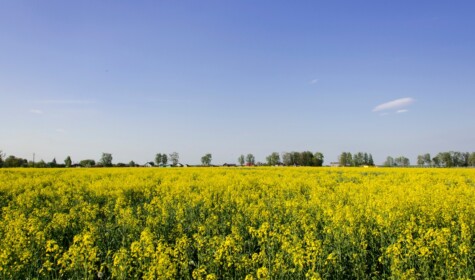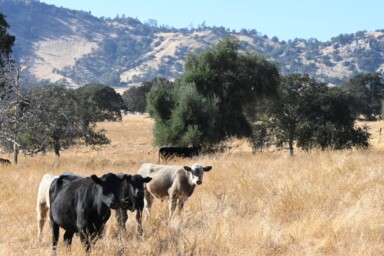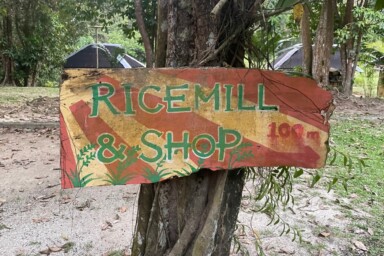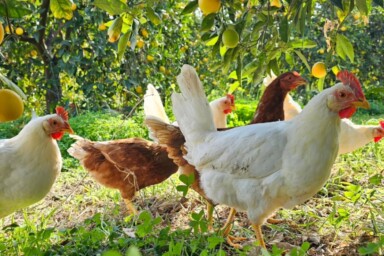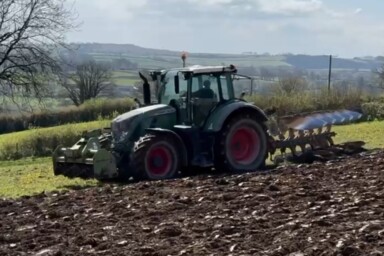Bright yellow fields of oilseed rape have become a feature of the British countryside only within living memory. It produces one of the most popular vegetable oils, but, grown as a monoculture over vast tracts of farmland, its impact on the environment, biodiversity and even some people’s health leaves a lot to be desired.
Oilseed rape (or ‘canola’ as it is known in some countries) is one of the world’s major oil crops and of the 70 million tonnes produced annually, 2.2 million tonnes is produced in the UK. It is one of the most common break crops here, taking up 522,000 hectares of farmland in 2017, according to The Department of Environment, Food and Rural Affairs (Defra). The crop is processed into rapeseed oil, though it didn’t really take off in Britain until after 1973 when Canadian scientists bred varieties that were lower in erucic acid and glucosinolate, which can give the oil a bitter taste and make it unsafe for human consumption. Since then its acreage has steadily increased and over the past decade the popularity of rapeseed oil has soared. It has lower amounts of saturated fatthan other cooking oils and relatively high levels of omega-3 polyunsaturated fat, adding to its popularity.
Rape is a high input, high output break crop. In recent decades it has become an important crop for intensive arable farmers, as it can provide a good income and goes well in a rotation with wheat, which is often the most profitable cereal crop.
Despite this, oilseed rape is not particularly sustainable in the way it is often grown. To maximise yields and profitability farmers generally use high applications of nitrogen fertiliser, some of which is washed into rivers and ground water by heavy rain. The crop is also extremely vulnerable to a large number of pests and diseases which are generally treated with a range of fungicides and insecticides.
In looking closer at the impacts of oilseed rape production, I asked two English oilseed rape farmers and a processor how the supply chain works.
The average yield is 3.2 tonnes per hectare, but, as one farmer explains, farms cannot make much money with less than 4 tonnes per hectare. He is producing 6 tonnes per hectare on his 3,500 hectare farm, so is well above the average. This suggests that there are some British farmers who are making a loss from oilseed rape production and that it can be financially unsustainable, sometimes even with high inputs of agrochemicals.
One explanation for this could be that some farmers trying to maximise income from wheat are growing rape one year in three instead of only one year in five as recommended. Another reasonfor falling yields has been the ban on the use of neonicotinoid insecticides, due to their harmful impact on pollinating insects and other wildlife. Yet in a way these two aspects are linked. If rape was not being grown so frequently in rotations, the evidence suggests that levels of disease and pest damage would be lower.
United Oilseeds, a farmers’ cooperative, is the middle man in this farmer’s supply chain. The oilseed farmer explains that the price United Oilseeds pays for his product is dependent on the world market and it is his responsibility to decide the best time to sell. He jokes that he often gets it wrong.
United Oilseeds then trades the crop to Archer Daniels Midland (ADM), a multinational oilseed and cereals processor. While the farmer makes about 2-3% profit on the crop, ADM makes around 15-20%. The farmer considers the profits taken by the processors unreasonable in comparison to what the producer receives.
“We’re forced to take the price offered on the contract by the purchaser or they will just change supplier,” he explains.
The last stage in the supply chain, the retailer, is so far removed, that farmers do not even know if the majority of their crop goes for oil, animal feed or biofuel. The farmer realises that he could be buying a product from the supermarket that contains some of his crop, but that there is no way of tracing it.
It is a common concern in agriculture that the power and the profit is concentrated with the retailers, according to a report by the Fairtrade Advocacy Office, Who’s Got the Power? The value of the oilseed rape crop gets higher and higher as it moves through the chain and becomes the packaged oil on our supermarket shelves.
Some farmers are choosing to take control into their own hands by processing their crops themselves. Charlie Beldam, who farms in Worcestershire, set up a crush – Cotswold Gold – during the 2008 recession, in order to diversify his family farm’s income.
Cotswold Gold produces cold-pressed rapeseed oil, using only Mr Beldam’s crops. On its website, the health benefits of cold-pressed rapeseed oil are highlighted as an important selling point. Studies have shown that quality indicators are higher for cold-pressed rapeseed oil than for hot-pressed, which explains why some consumers are prepared to pay a higher price.
By pressing his own oil, Mr Beldam feels he has more security. There is a great deal of uncertainty about the viability of the farming industry. Although subsidies should continue at least until March 2022, there is still uncertainty about how Brexit will impact the economy in the long-term. Currently, 84% of the UK’s total farming income comes from EU subsidies.
Diversification, such as oil pressing, is one way for farmers to improve their resilience, and to increase traceability of products. To some extent, diversification can help oilseed farmers to improve their environmental practices – a topic they insist they are concerned about. Mr Beldam’s farm aims to protect the environment where possible. He explains they are careful to choose a time to spray crops that minimises the risk to insect pollinators. Neither of the farmers I spoke with, like relying on chemical inputs, but both recognise consumers want food at a certain price and that they have to be efficient to meet demand.
Through speaking to farmers, it is clear that the supply chain of conventionally produced British rapeseed oil is neither traceable nor particularly environmentally friendly. And there are other problems with the crop too. Many people claim to be allergic to rape pollen and suffer weeks of unpleasant symptoms every spring when it is in flower. Also, despite the early success in reducing the levels of erucic acid, levels in some crops have increased due to the spread of weeds like charlock which looks almost identical to rape and which is very difficult to control with chemicals. At present rape used by the food industry can contain up to 5% erucic acid. The EU is proposing to reduce this to 2%, though what will happen in the UK post-Brexit is currently unknown.
Farmers often feel they have to deliver high outputs to be economically viable, resulting in intensive practices. Although diversification and cooperative working could enable farmers to increase their power in the supply chain, and to be in a better position to act on their environmental concerns, the larger question of how farmers can transition into more sustainable production in all-arable systems, while competing on the world market remains a tricky one.
